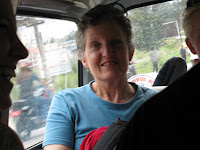Mum always used to say that if we won Lotto we would go trekking in Nepal, well here we are! Not quite trekking yet but it has been pretty much a week since Penny and I met the rest of the Stewart family in Kathmandu airport...
As this is Mum and Dads' first trip outside of New Zealand I was really looking forward to their first impressions. I was not disappointed seeing their dawning comprehension of the reality of Kathmandu on the short trip to the old town of Bhaktapur where we had booked to stay for the first few nights.
We chose Bhaktapur because it was supposed to be quiet and clean, but we hadn't counted on the Hindu festival of Dashain, which brings Nepal to a standstill as the victory of good (the gods) over evil (demons in the form of water buffalos) is celebrated. Everyone returns home to their villages, including Bhaktapur, and gives copious offerings to the gods often in the form of animal sacrifices. My brother Sam has posted some photos, but here is another one...instead of headless goats or ducks I give you a fair dinkum tractor worshipping photo, I have always named my cars and changed the old filter, but this is how you really appreciate an engine...
The old city of Bhaktapur really does justify its World Heritage listing, there are many amazing buildings most dating from the heyday of the city around 1700, but many from much earlier, we enjoyed many strolls through the various squares, shopping for handicrafts down the narrow lanes and plenty of teas in the cafes that oversee everything.
Some of the iconography is quite amusing, I like to think these carvers as well as been very religious also had a sense of humour.
We had one little outing from Bhaktapur, up the hill to Narakot which apparently has an amazing view of the himalayas on a good day...this wasn't one regrettably. We saw only a slither of the Langtang and perhaps the triangular face of Gaurasankar. However we did get to stretch our legs down the long ridge to Changu Narayan, via the local pie shops...
For a spot of luxury and some jungle we headed down to Chitwan National Park for a few day, staying at the super nice Sapana Village Lodge. We got out there into the jungle both on foot and by elephant, but by far the highlight was the elephant washing. Dad in particular really bonded with his elephant, they connected deeply, down even to the facial expressions...
We saw a bit of wildlife; the two types of crocodile, a couple of species of deer, some monkeys and plenty of cool birds, but for me the highlight has to be the elephants we were riding, what awesome creatures, riding one across a deep fast flowing river it seemed like they were built from stone, not flesh. Their big round footprints softly but heavily stamp a track perfectly flat, and from the foot up the animal is just so damn big and solid and heavy and old. So so cool.
Today we journeyed up from the heat of Chitwan to Pokhara, the gateway for the Annapurna. We will stay here for a couple of days getting permits etc (and shopping) before heading up by local bus and jeep hopefully as far as Muktinath (making the most of the new road) before slowly drifting back down. But yeah, what an experience, it is so amazing to have Mum, Dad, Gemma, and Sam here as well and be sharing it with them. Awesome.


























































